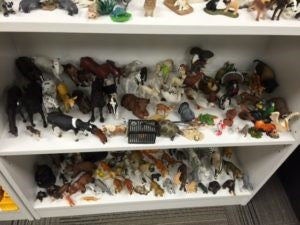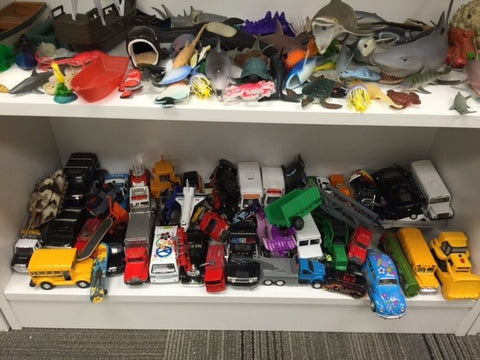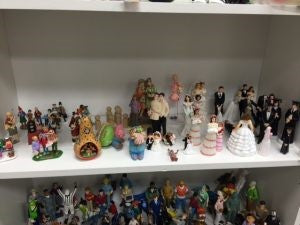
10 Categories for Sorting Sand Tray Miniatures on Shelves
Since I’ve been doing sand tray therapy trainings for several years now many folks have asked the best way to arrange miniatures on shelves. As an aside, don’t worry for you traveling, crammed-for-space-therapists- my next blog post will be just for you so be on the lookout! Now, back to the fun stuff. I’m going to show you how I arrange my miniatures and tell you my logic behind my placements. Plus, you’ll get to see most of my miniatures up close and personal, which I can bet will give you some miniature envy (there’s no such thing as ‘enough’ miniatures!) Okay! Roll up your sleeves and let’s dig in shall we?
1. Animals
To start, you can see my animal shelves below. I place my animals closest to the bottom because they are most used my younger kiddos. Young kids are most likely to use animals rather than people so putting them on the bottom just makes practical sense. Groupings of domesticated animals- try to put the horses and other types of animals together. Kids will often make families out of these. Horses get used a LOT. Scary spiders go at the bottom. These are a MUST for working with little boys.
CTT comment: Scroll down to “Animals” to see our entire selection.

2. Fantasy Figures
When I moved offices, I knew I had to dedicate more shelves to fantasy miniatures. These are also a must-have for your sand tray collection because they get used with all ages. Adults usually place them as metaphors or hobbies, but kids will tell lots of stories with the fantasy figures. Don’t worry- by placing an Elsa miniature there you aren’t guaranteed to hear the whole plot of Frozen. Dragon shelf: used for all ages but again little boys gravitate towards this shelf. Multiple-headed dragons are the best.

3. Transportation
If you work with kids AT ALL, you will likely have a difficult time keeping this shelf neat and tidy. Little boys typically LOVE to smash cars into each other. Remember, even if they can’t tell you what is happening in the tray, it doesn’t mean that nothing is happening. The brain never misses a chance to integrate.

4. People
When working with school age clients and older, having a variety of people is extremely helpful. Try to collect as many different ages, skin colors, and diverse abilities as possible. As you can see, I separated mine into gender and then had a shelf for groupings of people. I also made a separate placement just for what I think of as “milestone markers,” such as birth, weddings, graduation. Place these near the bottom so your kids can access people miniatures as needed. Children shelf on the bottom (babies are grouped) and then the women shelf above it. Can you spot my favorite?
CTT comment: Scroll down to “Figures” to see our entire selection.

5. Fences
I have an entire shelf devoted just to fences. You really can never have too many fences. Kids will often line the tray with fences and have fences inside of fences. A variety of size and shapes are helpful.
6. Treasure/Rocks
Just as fences get used in trays for all ages, so do treasure chests, treasures, and rocks. I try to place these near the middle on my shelves. Don’t worry about sorting all of your rocks because the kids will choose what they need anyway (and you will drive your OCD self insane if you make this a priority.)
CTT note: See the Landscape page as well.

7. Religion/Death shelves
Seems like an odd pairing at first huh? But, if you think about it, religion plays a key role in how we see death, so it makes sense to have these near each other. Clients of all ages will use these- adults again, perhaps more metaphorically but these two shelves do get a lot of use in my playroom. In case you can’t see, they are in the middle shelves.
8. Miscellaneous
But what about all that stuff that just doesn’t have a category? Round those up and put them on shelves you classify as “miscellaneous.” Adults LOVE these shelves. So many abstract thoughts and stories come from random miniatures. Always keep an eye out at yard sales and flea markets for one-of-a-kind miniatures to fill these shelves. Often those miniatures where I have NO CLUE how they could be used end up being the most popular ones!
I place my houses at the top because these rarely get used by little ones, but adults love to populate their trays with houses. A variety of houses is helpful for the client to find one that is “just right.” Bridges are often used by adults to symbolize hope and connection. Any time you see a bridge come into a tray, know you are on the right track.

10. Breakable/abstract ideas
I keep my breakable stuff on the top shelves. However, this doesn’t mean that stuff never gets broken. If you are super worried about it getting broken, it doesn’t belong in your collection. Put that on a bookshelf somewhere where you can admire it. Adults will be the ones who use these. Even then, it’s not super common for adults to use them. I think I have these for myself, if I’m honest.
CTT note: We have hundreds of miniatures and dozens of categories to choose from
Thanks to Amy Flaherty and The Southern Sandtray for this great post!
